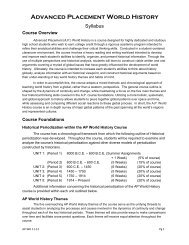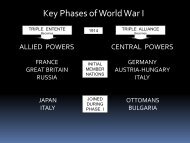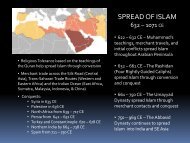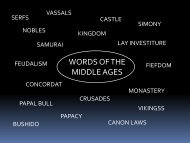Bloom's Taxonomy
Bloom's Taxonomy
Bloom's Taxonomy
Create successful ePaper yourself
Turn your PDF publications into a flip-book with our unique Google optimized e-Paper software.
BLOOM'S TAXONOMY<br />
In 1956, Benjamin Bloom headed a group of educational psychologists who developed a<br />
classification of levels of intellectual behavior important in learning. Bloom found that over<br />
95 % of the test questions students encounter require them to think only at the lowest<br />
possible level...the recall of information. Bloom identified six levels within the cognitive<br />
domain, from the simple recall or recognition of facts, through increasingly more complex<br />
and abstract mental levels, to the highest order of evaluation.<br />
Analysis:<br />
Evaluation:<br />
Knowledge:<br />
Comprehension:<br />
Synthesis:<br />
Application:
BLOOM'S TAXONOMY<br />
Knowledge is defined as remembering of<br />
previously learned material. This may involve the<br />
recall of a wide range of material, from specific<br />
facts to complete theories, but all that is<br />
required is the bringing to mind of the<br />
appropriate information. Knowledge represents<br />
the lowest level of learning outcomes in the<br />
cognitive domain.<br />
Comprehension is defined as the ability to grasp the meaning of material. This<br />
may be shown by translating material from one form to another (words to numbers),<br />
by interpreting material (explaining or summarizing), and by estimating furture trends<br />
(predicting consequences or effects). These learning outcomes go one step beyond<br />
the simple remembering of material, and represent the lowest level of<br />
understanding.
BLOOM'S TAXONOMY<br />
Application refers to the ability to use<br />
learned material in new and concrete situations.<br />
This may include the application of such things<br />
as rules, methods, concepts, principles, laws,<br />
and theories. Learning outcomes in this area<br />
require a higher level of understanding than<br />
those under comprehension.<br />
Analysis refers to the ability to break down material into its component parts so<br />
that its organizational structure may be understood. This may include the<br />
identification of the parts, analysis of the relationships between parts, and<br />
recognition of the organizational principles involved. Learning outcomes here<br />
represent a higher intellectual level than comprehension and application because<br />
they require an understanding of both the content and the structural form of the<br />
material.
BLOOM'S TAXONOMY<br />
Synthesis refers to the ability to put parts<br />
together to form a new whole. This may involve<br />
the production of a unique communication<br />
(theme or speech), a plan of operations<br />
(research proposal), or a set of abstract relations<br />
(scheme for classifying information). Learning<br />
outcomes in this area stress creative behaviors,<br />
with major emphasis on the formulation of new<br />
patterns or structures.<br />
Evaluation is concerned with the ability to judge the value of material (statement,<br />
novel, poem, research report) for a given purpose. The judgments are to be based on<br />
definite criteria. These may be internal criteria (organization) or external criteria<br />
(relevance to the purpose) and the student may determine the criteria or be given<br />
them. Learning outcomes in this area are highest in the cognitive hierarchy because<br />
they contain elements of all the other categories, plus conscious value judgments<br />
based on clearly defined criteria.
BLOOM'S TAXONOMY UPDATED<br />
During the 1990's a new group of cognitive psychologist, lead by Lorin Anderson (a former<br />
student of <strong>Bloom's</strong>), updated the taxonomy reflecting relevance to 21st century work. The<br />
graphic is a representation of the NEW verbage associated with the long familiar <strong>Bloom's</strong><br />
<strong>Taxonomy</strong>. Note the change from Nouns to Verbs to describe the different levels of the<br />
taxonomy.<br />
Remembering: can the student recall or remember the information?<br />
Understanding: can the student explain ideas or concepts?<br />
Applying: can the student use the information in a new way?<br />
Analyzing: can the student distinguish between the<br />
different parts?<br />
Evaluating: can the student justify a stand or decision?<br />
Creating: can the student create new product or<br />
point of view?<br />
Note that the top two levels are essentially exchanged from the Old to the New version.
















